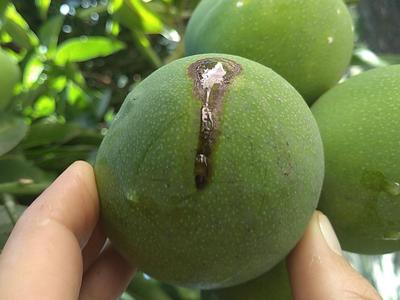Mango Fruit Fly
Ceratitis cosyra
Insect
5 mins to read
In a Nutshell
- Brown lesions on peel.
- Discoloration of fruit.
- Secrete fruit juice and gummy consistency.
- Exit holes visible.
- Flies with yellowish body with black spots on thorax.
Can also be found in
Symptoms
The symptoms for C. cosyra infection are exclusively visible on the fruits. The females inject their eggs predominantly into matured mangos. The affected fruits exhibit a gummy consistence due to the internal feeding and the digesting process of the larvae. The exit holes of the larvae are visible on the surface of the fruit. Inner decomposition results in brown and sometimes black lesions on the peel. The peel may also be scabbed or pitted. The fruits may discolor and show stains of mold as they progressively decay. They subsequently feature a foul odor and may secrete a mixture of fungal and fruit ooze.
Recommendations

Organic Control
Traps containing protein baits can be effective for the monitoring and catching of C. cosyra populations. The fungus Metarhizium anisopliae parasitizes the pupae of C. cosyra on the ground and can be dispersed by hand or as oil-based spray. Post-harvest hot water treatment of the fruits at temperatures above 46 degrees or prolonged storage at 7.5 degrees or below also destroy the larvae.

Chemical Control
Always consider an integrated approach with preventive measures together with biological treatments if available. Traps containing an insecticide (e.g. deltamethrin) combined with a specific bait (protein hydrolysate or protein autolysate) are recommended. This method ensures punctual treatment of the flies, attracting all surrounding individuals. Males of C. cosyra can be attracted and trapped with terpineol acetate or methyl eugenol.
What caused it?
The symptoms are caused by the larvae of the fruit fly Ceratitis cosyra. Adults have a yellowish body with black spots scattered on the thorax. Their wings are yellow and may reach a span of 4-6 mm. Females implant eggs into the ripening mango fruits and continue to do so for about two weeks. After 2-3 days, the larvae hatch and start digging tunnels through the mango flesh. Fruits may be infested with up to 50 larva each and can sometimes start to show symptoms only after harvest. To pupate, the larvae let themselves fall onto the ground and dig into the upper layers of the soil. After 9 to 12 days the fully grown flies hatch.
Preventive Measures
- Plant early-maturing varieties to make sure the fruits ripen when fly populations are low.
- Pick infested or dropped fruits every day.
- Install protein bait traps to monitor possible fly invasions.
- Do not grow alternative host plants such as citrus, guava, papaya, melons, etc nearby.
- Weed and till carefully around the trees to detect fallen fruits under residues.
- Preferably grow mango varieties with similar growth cycles.
- Transport and sell unaffected mangos only.
- Ensure immediate consumption or proper destruction of unsold fruit.
- Tilling around the trees kills the ground-developing pupae.



